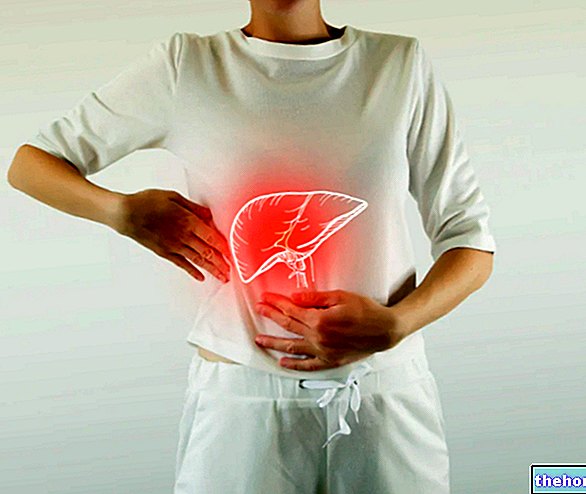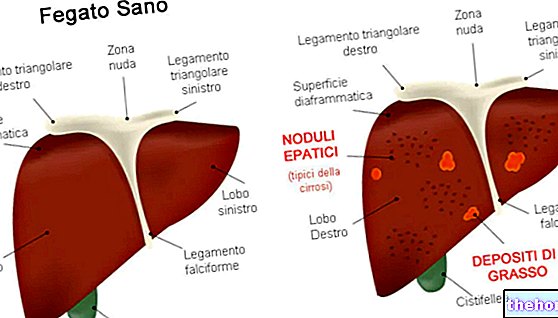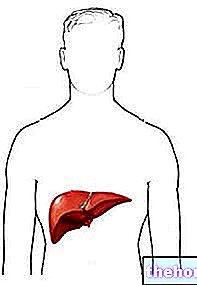The blood sample thus obtained is then analyzed in the laboratory, in order to determine the markers of liver function and health (ie to establish the plasma concentration of the substances that have to do with the efficiency and structural integrity of the organ).
Now let's see in detail what these values are and what meaning to attribute to any anomalies. Before listing them, however, it should be pointed out that these are generally nonspecific indices, such that any variations in excess or deficiency do not necessarily indicate a liver problem.
For this reason, to identify with certainty a liver disease, in addition to comparing the values of several markers, it may be necessary to resort to ultrasound scans or biopsies of the organ.

In relation to the doctor's decisions and the availability of the laboratory, liver function tests may also include the analysis of:
- Fibrinogen;
- Lactic dehydrogenase (LDH);
- Viral hepatitis markers;
- Pseudocolinesterase.
When is the exam required?
The doctor can check the liver values when he suspects that the organ may have some known or suspected problem, or in cases where the patient is taking hepatotoxic drugs.
The liver panel is also indicated when symptoms of liver disease are found, such as:
- Jaundice (yellow discoloration of the skin, sclerae and other tissues caused by an excess of circulating bilirubin);
- Dark urine
- Nausea, vomiting and / or diarrhea;
- Loss of appetite
- Stool with bloody or dark traces
- Swelling or pain in the belly
- Changes in body weight
- Fatigue or weakness.
One or more of these liver values can also be assessed when a person habitually consumes excess alcohol or has been exposed to hepatitis viruses.
. Its values decrease in the presence of chronic liver diseases, such as cirrhosis, due to reduced synthesis. The same result can be had in the presence of chronic kidney diseases (nephrotic syndrome), due to the abnormal loss of albumin in the urine, but also in the presence of severe malnutrition, prolonged fasting, protein catabolism and numerous other conditions. hepatic protein synthesis is evaluated by preferably measuring other markers, such as coagulation factors.The comparison of these and other enzymes with the creatine kinase values, can confirm or deny the hepatic origin of the problem. Creatine kinase increases in fact in the presence of a muscle lesion, so normal values associated with high ALT values suggest a problem to the liver.
TOTAL BILIRUBIN
DIRECT
The excess of bilirubin in the blood gives the skin and eye sclera a yellowish color (jaundice).
0.1-1.2 mg / dL DIRECT
0-0.3 mg / dL
PRO-
THROMBINE
DEHYDRO-GENASES
IMMUNO-
LOGICAL
The search for auto-antibodies can instead be conducted in the presence of suspicions on possible autoimmune liver diseases, triggered by the presence of abnormal antibodies directed against the same cells of the organism (primary biliary cirrhosis, autoimmune hepatitis, primary sclerosing cholangitis).
and Crigler-Najjar.
An increase in direct bilirubin may result from:
- Liver disease, such as cirrhosis, viral and toxic hepatitis;
- Obstruction of the biliary tract due, for example, to stones or tumors of the liver or pancreas.
Transaminases
Extremely high transaminase values indicate acute liver cell necrosis or liver damage due to:
- Acute viral hepatitis;
- Hepatitis induced by toxins or drugs;
- Ischemic hepatitis or hepatic infarction.
In these cases, liver values are elevated for days or, in the case of viral hepatitis, even for weeks.
Values higher than normal can also be determined by:
- Cirrhosis of the liver from any cause;
- Non-alcoholic steatosis;
- Cholestatic disorders;
- Hepatocarcinoma;
- Liver metastases;
- Acute exacerbation of autoimmune hepatitis;
- Reactivation of chronic hepatitis B;
- Acute Budd-Chiari Syndrome;
- Fatty liver disease of pregnancy.
Moderate increases can be seen in chronic liver disorders (chronic and alcoholic hepatitis) and bile duct obstruction.
The increase in ALT (alanine aminotransferase) may also depend on diseases affecting organs and tissues other than the liver: for example, muscular dystrophies, circulatory decompensation, trauma, obesity, pancreatitis, destruction of red blood cells (haemolysis) and mononucleosis (the so-called kissing disease).
Alkaline phosphatase
ALP values increase significantly when there is an "alteration of the biliary tract (such as an" obstruction) and, to a lesser degree, in the case of liver disorders, such as:
- Hepatitis;
- Cirrhosis;
- Tumor;
- Infiltrating disorders (amyloidosis, sarcoidosis, TB, abscesses and metastases).
Occasionally, isolated increases may occur even in the absence of obvious hepatic or biliary disorders:
- Some tumors with no obvious liver involvement;
- After ingestion of high-fat meals;
- Pregnancy;
- Growing children and adolescents (due to bone development);
- Chronic renal failure.
Gamma-glutamyl transpeptidase (GGT)
Elevated GGT values are found in hepatobiliary dysfunction, particularly in cholestasis.
The increase in gamma-glutamyl transpeptidases is also observed during alcohol consumption and in some diseases, such as congestive heart failure.
When alkaline phosphatase is increased, if GGT is also increased, then hepatic or biliary dysfunction may be suspected; if, on the other hand, the gamma-glutamyl transpeptidase is normal, the increase in alkaline phosphatase is more likely to indicate bone disease.
Prothrombin time (PT)
A prolongation of PT can be observed in liver disease, vitamin K deficiency, during the use of drugs that reduce the risk of thrombosis (warfarin), and in the deficiency of clotting factors.
, chronic inflammation and protein malnutrition reduce the synthesis of this protein.Another cause may be excessive loss through the kidneys (nephrotic syndrome), intestines or skin (eg severe burns).
Bilirubin
A decrease in bilirubin levels can be caused by:
- Some types of anemia (aplastic and iron deficient);
- Taking certain sedatives (e.g. barbiturates).
Alkaline phosphatase
A decrease in alkaline phosphatase can also be caused by hypothyroidism, anemia, malnutrition, or old age.
Gamma-glutamyl transpeptidase (GGT)
Low or normal GGT levels are of no concern, as they are indicative of good liver function: the chances of the patient suffering from liver disease are therefore low. In some cases, the reduction in GGT may be due to the intake of certain medications, such as the birth control pill or clofibrates.
.
















.jpg)











